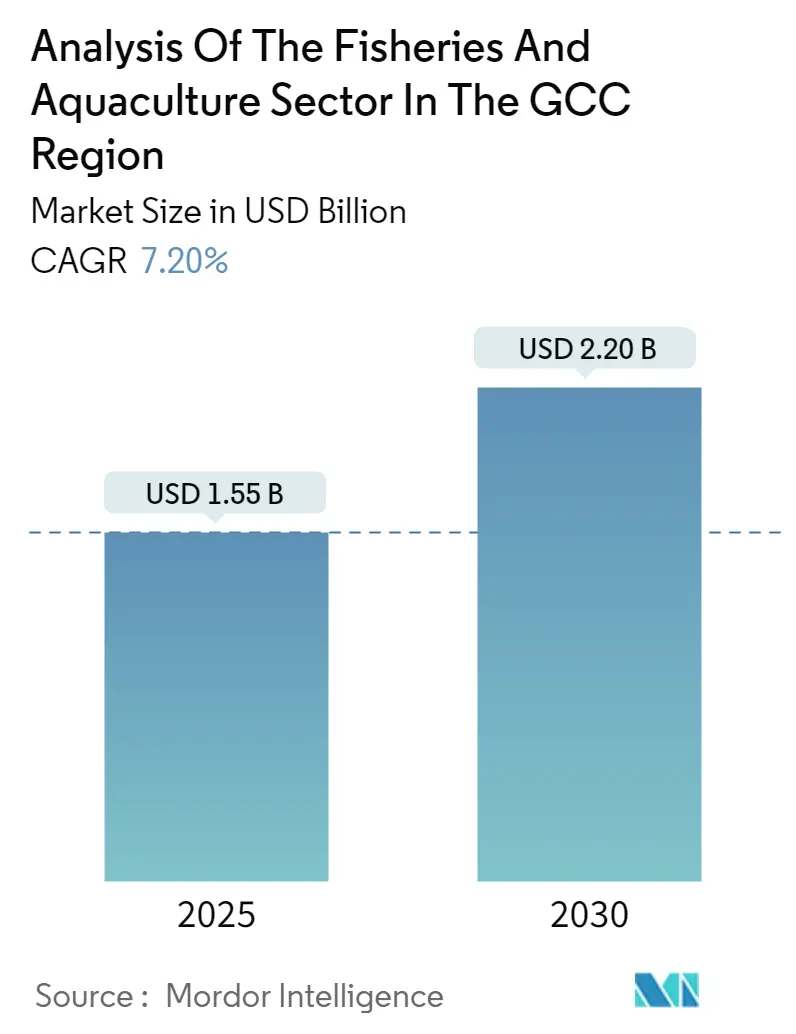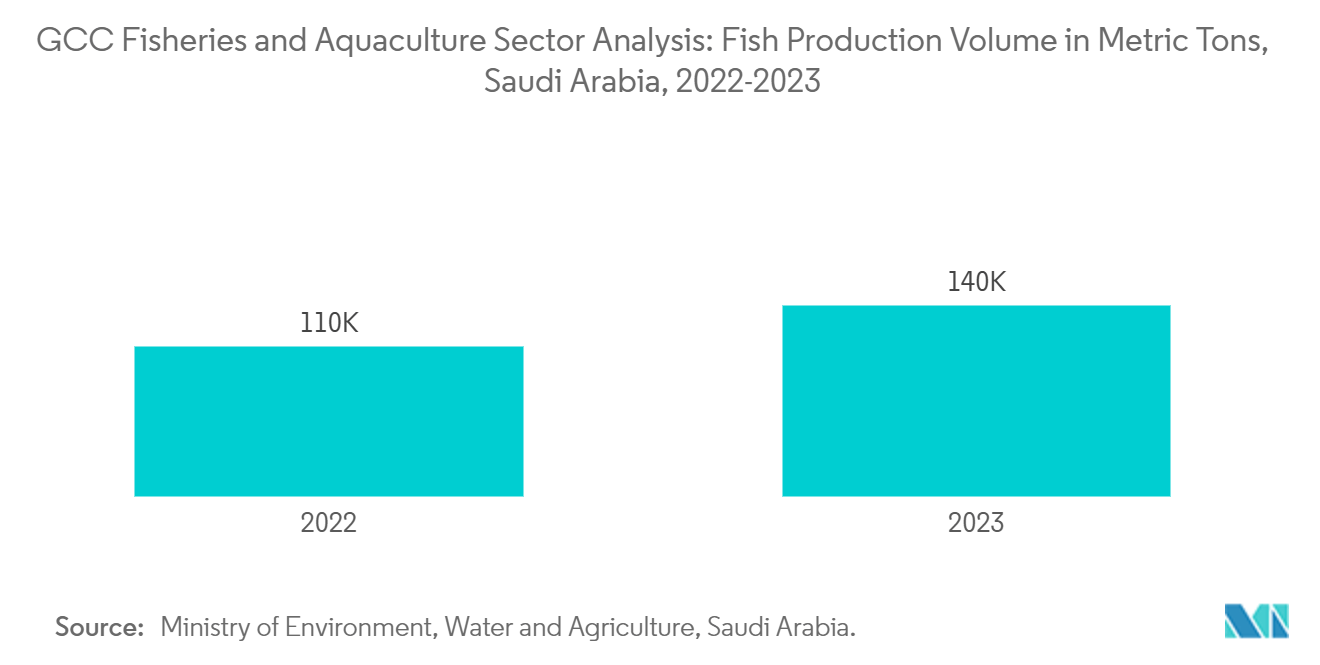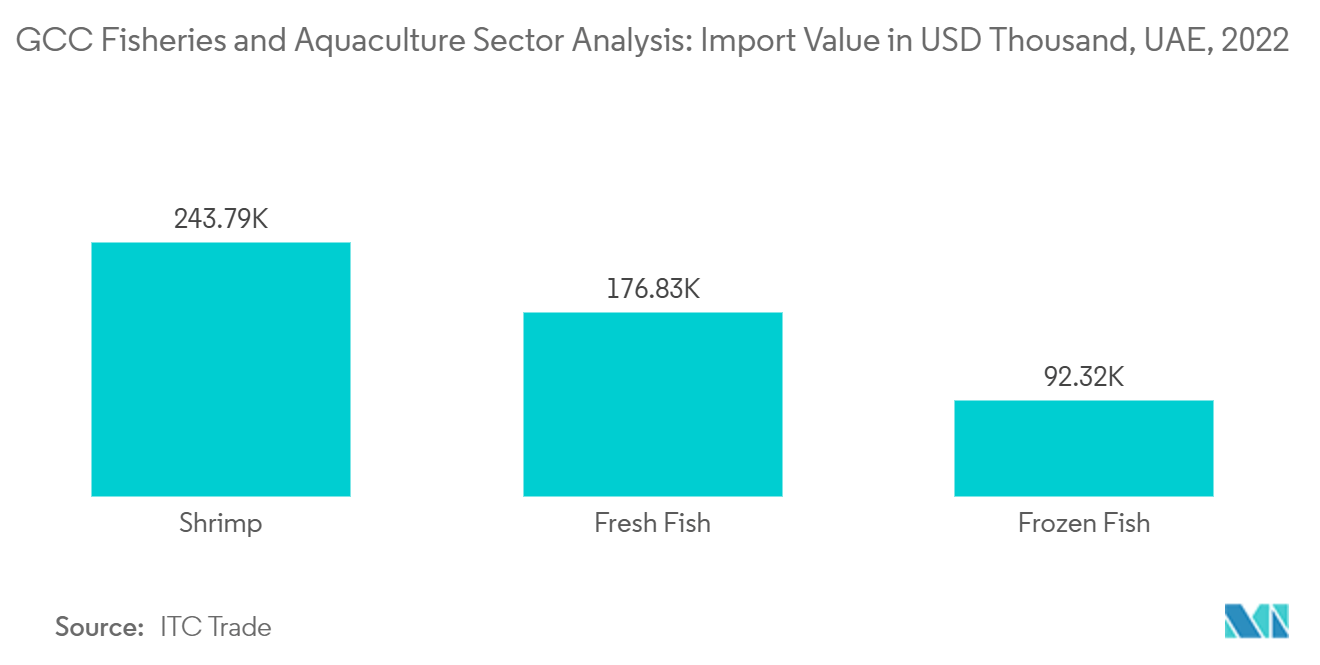GCC Fisheries and Aquaculture Market Analysis
The Analysis Of The Fisheries And Aquaculture Sector In The GCC Region Market size is estimated at USD 1.55 billion in 2025, and is expected to reach USD 2.20 billion by 2030, at a CAGR of 7.2% during the forecast period (2025-2030).
- The drivers identified in the market are a rapid rise in the population, an increase in affluent households, a focus on diversification, and changing diet preferences. As seafood continues to be a preferred healthy choice at events and restaurants, the fisheries market in Saudi Arabia is poised for growth in the coming years. According to the Ministry of Environment, Water, and Agriculture, Saudi Arabia's seafood and fisheries consumption is projected to rise at an annual rate of 7.4% through 2030.
- The cuisine of GCC nations boasts a rich tradition of seafood dishes, deeply rooted in the region's coastal heritage. Traditional recipes and delicacies prominently feature fish, shrimp, and other seafood. The seafood market is shaped by religious practices, notably the Islamic dietary laws (Halal). GCC countries procure seafood from a diverse array of suppliers, spanning neighboring nations to distant sources like India, Oman, China, and various European countries. Common imports include shrimp, fish fillets, crab, lobster, and other premium species. Data from ITC Tradmap reveals that in 2022, the GCC region's imports included fresh fish exceeding USD 532 million and frozen fish surpassing USD 265 million.
- In response to shifting local fish consumption patterns and rising demand, the GCC aquaculture sector has witnessed a surge in local infrastructure projects, bolstered by public support. Abu Dhabi's Environment Agency (EAD) has unveiled its inaugural sea-cage aquaculture initiative, harnessing artificial intelligence (AI) tools. Targeting an annual yield of 100 metric tons, the project seeks to alleviate the strain on wild fisheries. Situated southeast of Delma Island in the Al Dhafra Region, the initiative will spearhead scientific studies on local fish species and floating aquaculture cage systems. Additionally, it aims to establish environmental protocols for sustainable sea-based aquaculture in Abu Dhabi. Beyond easing the burden on wild fisheries and tackling climate change challenges, the project bolsters food security amidst rising seafood demand and paves the way for future sector investments.
GCC Fisheries and Aquaculture Market Trends
Government Initiatives Boost Domestic Fish Production
- Governments in the Gulf region have crafted policies and created favorable investment conditions to elevate fish farming in the area. Key drivers for the region's aquaculture sector development include a heavy reliance on imports, the need to conserve limited freshwater resources, and the potential for export surpluses.
- The Saudi Ministry is pivotal in expanding the aquaculture sector, aiming to meet domestic needs and generate export surpluses. In 2023, Saudi Arabia's aquaculture production hit 140,000 metric tons, increased from 110,000 from 2022, with aspirations to exceed 600,000 metric tons by 2030. Given these ambitions and supportive government policies, the aquaculture industry is poised for growth during the forecast period.
- Oman's Ministry of Agriculture and Fisheries has been heavily investing in the aquaculture sector's growth. In August 2024, the Omani government unveiled a USD 115 million investment plan, introducing 24 new opportunities. These opportunities span the establishment, management, and operation of fish markets, collection centers, shops, marine workshops, and cold storage facilities across various governorates. In another move, Fisheries Development Oman (FDO), the fisheries investment arm of the state-owned Oman Investment Authority (OIA), inked an advisory contract in 2024 with Malta's AquaBioTech Group. AquaBioTech is set to offer a suite of consulting and advisory services, aiding FDO in cultivating a sustainable aquaculture and fisheries sector in Oman, including business strategy formulation and technical due diligence.
United Arab Emirates is the Region's Top Importer
- The United Arab Emirates (UAE) government is focusing on increasing aquaculture projects as it is a viable source for improving the region's food security which is the major concern in the country. Rapid growth and development and the diverse population of the UAE, coupled with the rising consumption of seafood, are likely to be the major factors that is driving the fisheries and aquaculture sector.
- Data from ITC Trademap highlights that shrimp topped the import list, valued at a substantial USD 243,787 Thousand. Other notable imported species encompassed Salmon, Sea Bass, and Sea Bream. Consumers in the UAE show a preference for various fish species. These include small pelagic varieties like sardines and mackerel, as well as larger pelagic types such as tuna. Additionally, species like grouper, emperor, tilapia, and pomfret enjoy significant popularity in the nation.
- Over the past five years, Russia has nearly doubled its fish and seafood shipments to the UAE, rising from USD 3.4 million in 2019 to USD 6.5 million in 2023, as reported by the Analytical Center of the Fisheries Union, Russia. Crustaceans dominate the UAE's imports from Russia. Specifically, crab and shrimp make up 36% of the imports, followed by chilled fish at 20%, canned fish at 17%, frozen fish at 11%, and fish fillets at 7%. In terms of value, frozen Kamchatka crab constitutes nearly 70% of Russian exports, with canned crab at 24%, smoked fish at 4%, and caviar at 3%.
GCC Fisheries and Aquaculture Market News
- September 2024: The Oman Investment Authority (OIA) facilitated the merger of Fisheries Development Oman (FDO) with Oman Food Investment Holding Company (NITAJ). This strategic move aims to optimize operational efficiency and reduce expenditures for both entities. Furthermore, the merger is poised to bolster Oman’s food security, elevate product quality, and enhance cost efficiency, all in alignment with Oman Vision 2040.
- July 2024: The National Centre of Fisheries, Saudi Arabia granted 18 licenses for aquaculture projects in the Mecca region, encompassing roughly one-third of Saudi Arabia's Red Sea coastline.
- December 2023: Aqua Bridge Group, a company focused on aquaculture development, and Enertech, the Kuwait-based innovator, investor, and developer of end-to-end sustainable solutions, have announced the launch of Aqua Bridge Kuwait on the side-lines of COP28 in Dubai, UAE The joint venture aims to build a sustainable agri-food system that is equipped to cope with global economic shocks and disruptions.
GCC Fisheries and Aquaculture Industry Segmentation
Fisheries and aquaculture can be defined as raising or capturing aquatic organisms, including wild marine and freshwater fish, for food or industrial purposes. The fisheries and aquaculture sector in the GCC region is segmented by type (Pelagic fish, Demersal fish, Freshwater fish, Scallop, Shrimp. Lobster, Caviar, and Salmon) and geography (Saudi Arabia, United Arab Emirates, Oman, Qatar, Bahrain, and Kuwait). The market includes production analysis (volume), consumption analysis (value and volume), export analysis (value and volume), import analysis (value and volume), and price trend analysis across the GCC. The report offers market estimation and forecasts in value (USD) and volume (Metric tons) for the above-mentioned segments.
| Type | Pelagic Fish | Sardine | Production Analysis by Volume | |
| Consumption Analysis by Value and Volume | ||||
| Import Analysis by Value and Volume | ||||
| Export Analysis by Value and Volume | ||||
| Wholesale Price Trend Analysis | ||||
| Mackerel | Production Analysis by Volume | |||
| Consumption Analysis by Value and Volume | ||||
| Import Analysis by Value and Volume | ||||
| Export Analysis by Value and Volume | ||||
| Wholesale Price Trend Analysis | ||||
| Tuna | Production Analysis by Volume | |||
| Consumption Analysis by Value and Volume | ||||
| Import Analysis by Value and Volume | ||||
| Export Analysis by Value and Volume | ||||
| Wholesale Price Trend Analysis | ||||
| Barracuda | Production Analysis by Volume | |||
| Consumption Analysis by Value and Volume | ||||
| Import Analysis by Value and Volume | ||||
| Export Analysis by Value and Volume | ||||
| Wholesale Price Trend Analysis | ||||
| Demersal Fish | Grouper | Production Analysis by Volume | ||
| Consumption Analysis by Value and Volume | ||||
| Import Analysis by Value and Volume | ||||
| Export Analysis by Value and Volume | ||||
| Wholesale Price Trend Analysis | ||||
| Trevally | Production Analysis by Volume | |||
| Consumption Analysis by Value and Volume | ||||
| Import Analysis by Value and Volume | ||||
| Export Analysis by Value and Volume | ||||
| Wholesale Price Trend Analysis | ||||
| Emperor | Production Analysis by Volume | |||
| Consumption Analysis by Value and Volume | ||||
| Import Analysis by Value and Volume | ||||
| Export Analysis by Value and Volume | ||||
| Wholesale Price Trend Analysis | ||||
| Pomfret | Production Analysis by Volume | |||
| Consumption Analysis by Value and Volume | ||||
| Import Analysis by Value and Volume | ||||
| Export Analysis by Value and Volume | ||||
| Wholesale Price Trend Analysis | ||||
| Freshwater Fish | Tilapia | |||
| Production Analysis by Volume | ||||
| Consumption Analysis by Value and Volume | ||||
| Import Analysis by Value and Volume | ||||
| Export Analysis by Value and Volume | ||||
| Wholesale Price Trend Analysis | ||||
| Scallop | Production Analysis by Volume | |||
| Consumption Analysis by Value and Volume | ||||
| Import Analysis by Value and Volume | ||||
| Export Analysis by Value and Volume | ||||
| Wholesale Price Trend Analysis | ||||
| Lobster | Production Analysis by Volume | |||
| Consumption Analysis by Value and Volume | ||||
| Import Analysis by Value and Volume | ||||
| Export Analysis by Value and Volume | ||||
| Wholesale Price Trend Analysis | ||||
| Shrimp | Production Analysis by Volume | |||
| Consumption Analysis by Value and Volume | ||||
| Import Analysis by Value and Volume | ||||
| Export Analysis by Value and Volume | ||||
| Wholesale Price Trend Analysis | ||||
| Caviar | Production Analysis by Volume | |||
| Consumption Analysis by Value and Volume | ||||
| Import Analysis by Value and Volume | ||||
| Export Analysis by Value and Volume | ||||
| Wholesale Price Trend Analysis | ||||
| Salmon | Production Analysis by Volume | |||
| Consumption Analysis by Value and Volume | ||||
| Import Analysis by Value and Volume | ||||
| Export Analysis by Value and Volume | ||||
| Wholesale Price Trend Analysis | ||||
| Geography | Saudi Arabia | Production Analysis by Volume | ||
| Consumption Analysis by Value and Volume | ||||
| Import Analysis by Value and Volume | ||||
| Export Analysis by Value and Volume | ||||
| Wholesale Price Trend Analysis | ||||
| United Arab Emirates | Production Analysis by Volume | |||
| Consumption Analysis by Value and Volume | ||||
| Import Analysis by Value and Volume | ||||
| Export Analysis by Value and Volume | ||||
| Wholesale Price Trend Analysis | ||||
| Oman | Production Analysis by Volume | |||
| Consumption Analysis by Value and Volume | ||||
| Import Analysis by Value and Volume | ||||
| Export Analysis by Value and Volume | ||||
| Wholesale Price Trend Analysis | ||||
| Qatar | Production Analysis by Volume | |||
| Consumption Analysis by Value and Volume | ||||
| Import Analysis by Value and Volume | ||||
| Export Analysis by Value and Volume | ||||
| Wholesale Price Trend Analysis | ||||
| Bahrain | Production Analysis by Volume | |||
| Consumption Analysis by Value and Volume | ||||
| Import Analysis by Value and Volume | ||||
| Export Analysis by Value and Volume | ||||
| Wholesale Price Trend Analysis | ||||
| Kuwait | Production Analysis by Volume | |||
| Consumption Analysis by Value and Volume | ||||
| Import Analysis by Value and Volume | ||||
| Export Analysis by Value and Volume | ||||
| Wholesale Price Trend Analysis | ||||
GCC Fisheries and Aquaculture Market Research FAQs
How big is the Analysis Of The Fisheries And Aquaculture Sector In The GCC Region Market?
The Analysis Of The Fisheries And Aquaculture Sector In The GCC Region Market size is expected to reach USD 1.55 billion in 2025 and grow at a CAGR of 7.20% to reach USD 2.20 billion by 2030.
What is the current Analysis Of The Fisheries And Aquaculture Sector In The GCC Region Market size?
In 2025, the Analysis Of The Fisheries And Aquaculture Sector In The GCC Region Market size is expected to reach USD 1.55 billion.
What years does this Analysis Of The Fisheries And Aquaculture Sector In The GCC Region Market cover, and what was the market size in 2024?
In 2024, the Analysis Of The Fisheries And Aquaculture Sector In The GCC Region Market size was estimated at USD 1.44 billion. The report covers the Analysis Of The Fisheries And Aquaculture Sector In The GCC Region Market historical market size for years: 2019, 2020, 2021, 2022, 2023 and 2024. The report also forecasts the Analysis Of The Fisheries And Aquaculture Sector In The GCC Region Market size for years: 2025, 2026, 2027, 2028, 2029 and 2030.
Our Best Selling Reports
GCC Aquaculture Industry Report
Statistics for the 2025 Analysis Of The Fisheries And Aquaculture Sector In The GCC Region market share, size and revenue growth rate, created by Mordor Intelligence™ Industry Reports. Analysis Of The Fisheries And Aquaculture Sector In The GCC Region analysis includes a market forecast outlook for 2025 to 2030 and historical overview. Get a sample of this industry analysis as a free report PDF download.





